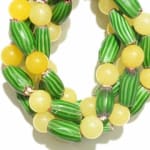Venetian Glass Trade Bead and Chalcedony Bead Necklace, 18th Century CE - 20th Century CE
Glass and Chaldedony
FJ.4391
During the late Middle Ages and throughout the renaissance, Venetian artisans rediscovered the ancient secrets of glass making. On the island of Murano, they created superb vessels and jewelry which...
During the late Middle Ages and throughout the renaissance, Venetian artisans rediscovered the ancient secrets of glass making. On the island of Murano, they created superb vessels and jewelry which were valued throughout the known world. It was also during this period that Venice became the most powerful trading nation in Europe, a city whose ships visited every port both east and west. Venetian traders used glass beads for barter, and these jewels became especially prized in Africa, where they were traded for gold, ivory, rare woods and spices. Venetian beads quickly became a medium of exchange throughout Africa, and in some tribes were used as a bridal dowry. The rare and subtle beauty of these beads continues to dazzle the senses even after the passage of centuries.
Usually very light in color-- either white, pink, greyish or blue-chalcedony is a translucent or transparent cryptocrystalline variety of quartz almost always used in cabochon form for gems. It is most commonly found in the deep recesses of volcanic rocks and in Antiquity the most prized variety came from Chalcedon in Bithynia in Asia Minor. The Egyptians, Romans and peoples of the Holy Land frequently carved intaglio gems into it, preferring the milky white variety above all others. Medicinally, Chalcedony is said to have the power to drive away fevers, to cure or prevent diseases of the eye (especially cataracts) and to aid in the relief of gallstones. It was one of the amulet stones used by the ancients to banish bad dreams. Modern science has developed the technique for changing chalcedony's color with a variety of dyes, which makes it a popular stone for jewelry. Its colors are generally of the soothing variety, and those who chose to wear the stone are blessed with a peaceful and equable disposition.
Usually very light in color-- either white, pink, greyish or blue-chalcedony is a translucent or transparent cryptocrystalline variety of quartz almost always used in cabochon form for gems. It is most commonly found in the deep recesses of volcanic rocks and in Antiquity the most prized variety came from Chalcedon in Bithynia in Asia Minor. The Egyptians, Romans and peoples of the Holy Land frequently carved intaglio gems into it, preferring the milky white variety above all others. Medicinally, Chalcedony is said to have the power to drive away fevers, to cure or prevent diseases of the eye (especially cataracts) and to aid in the relief of gallstones. It was one of the amulet stones used by the ancients to banish bad dreams. Modern science has developed the technique for changing chalcedony's color with a variety of dyes, which makes it a popular stone for jewelry. Its colors are generally of the soothing variety, and those who chose to wear the stone are blessed with a peaceful and equable disposition.



